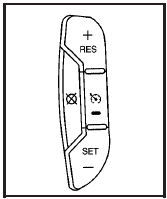Cruise Control
With cruise control, you can maintain a speed of about 40 km/h (25 mph) or more without keeping your foot on the accelerator. Cruise control does not work at speeds below about 40 km/h (25 mph).
WARNING:
Cruise control can be dangerous where you
cannot drive safely at a steady speed. So, do not
use the cruise control on winding roads or in
heavy traffic.
Cruise control can be dangerous on slippery
roads. On such roads, fast changes in tire traction
can cause excessive wheel slip, and you could
lose control. Do not use cruise control on slippery
roads.
If your vehicle has the Traction Control System (TCS) and the cruise control is on, TCS will begin to limit wheel spin and the cruise control automatically turns off.
See Traction Control System (TCS). When road conditions allow you to safely use it again, the cruise control can be turned back on.

The cruise control buttons are located on left side of the steering wheel.
 (On/Off): Press to turn cruise
control on and off.
(On/Off): Press to turn cruise
control on and off.
The indicator is lit when cruise control is on.
+ RES (Resume/Accelerate): Press to make the vehicle accelerate or resume to a previously set speed.
SET–: Press to set the speed or make the vehicle decelerate.
 (Cancel): Press to cancel cruise
control.
(Cancel): Press to cancel cruise
control.
See also:
Express Window Operation
Windows with an express-up or down feature allow the front windows to be lowered
or raised without holding the switch. Rear windows only have express-down. Pull
a window switch up or push it down ...
Danger, Warnings, and Cautions
Warning messages found on vehicle labels and in this manual describe hazards and what to do to avoid or reduce them.
Danger indicates a hazard with a high level of risk which will result in serious i ...
Doing Your Own Service Work
WARNING:
You can be injured and the vehicle could be
damaged if you try to do service work on a vehicle
without knowing enough about it.
• Be sure you have sufficient knowledge,
experience, ...


